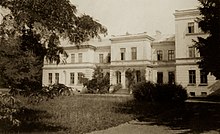Hlyboka
| Hlyboka | ||
| Глибока | ||

|
|
|
| Basic data | ||
|---|---|---|
| Oblast : | Chernivtsi Oblast | |
| Rajon : | Hlyboka district | |
| Height : | 342 m | |
| Area : | 6.47 km² | |
| Residents : | 9,223 (2007) | |
| Population density : | 1,426 inhabitants per km² | |
| Postcodes : | 60400 | |
| Area code : | +380 3734 | |
| Geographic location : | 48 ° 5 ' N , 25 ° 56' E | |
| KOATUU : | 7321055100 | |
| Administrative structure : | 1 urban-type settlement | |
| Mayor : | Kostjantyn Horjatschko | |
| Address: | вул. Шевченка 1 60400 смт. Глибока |
|
| Statistical information | ||
|
|
||
Hlyboka ( Ukrainian Глибока ; German and Polish Hliboka , Russian Глыбокая Glybokaja , Romanian Adâncata ) is an urban-type settlement in the Ukrainian Oblast of Chernivtsi . It is located south of the Prut , about 23 km south of Chernivtsi in northern Bukovina .
history
The settlement was mentioned in writing for the first time in 1438 and then belonged to the Principality of Moldova until 1774 . After that it was part of Austria in the crown land of Bukovina.
In 1869 the place was connected to the railway network through the construction of the Chernivtsi – Suczawa line (owned by the Lemberg-Chernivtsi-Jassy Railway ), and on November 30, 1886, the local railway Hliboka – Berhometh on the Sereth , built under the leadership of the Bukovina local railways , was added , on January 1, 1897 followed by the local railway Hliboka – Sereth operated by the New Bukovina Local Railway Company .
Large parts of the place were in the hands of Polish nobles, most recently the Skibniewski family .
Since 1857, German settlers from other colonies in Galicia and Bukowina began to settle in the existing settlement; 85% of them were Protestant. From November 1865 there was also a private Protestant primary school, which was enlarged in 1902 and converted into a public school; this happened in the course of the "conversion of the school into a parish" (according to the presbytery in Chernivtsi), with the old school building being converted into a parsonage.
In addition to the Greek Catholic Church (for the Ukrainians) there was a Roman Catholic chapel (for the Poles) and a Greek-Oriental church (for the Romanians). In 1885 the German community inaugurated the Protestant church, which in 1903 also received an organ. A Protestant church was also inaugurated in 1908 in Terescheny, a community connected with Hlyboka, where a small German settlement had also formed around the turn of the century. From 1905 the Protestant parish Hlyboka was an independent parish; six pastors worked there in succession until 1940.
After the end of the First World War, the place became part of Romania (in Storojineț district ) and became a border town with Poland. The resettlement of the Germans agreed by Hitler with Stalin ended the presence of the Germans in Hlyboka in 1940 (see Bukowinadeutsche ). In the course of the annexation of Northern Bukovina on June 28, 1940, it became part of the Soviet Union (between 1941–1944, it became part of Romania) and has been part of Ukraine since 1991.
In 1956, Hlyboka was elevated to an urban-type settlement.
From 1959 to 1992 the northeastern village of Dymka was also part of the municipality.
literature
- Müller, Edgar: The Protestant Parish Hliboka , series of publications by the Auxiliary Committee of Protestant Resettlers from Bukovina, Part V, (1984)
Individual evidence
- ↑ Müller, Edgar: The Protestant Parish Hliboka , series of publications by the auxiliary committee of evangelical resettlers from Bukowina, Part V, (1984), p. 15 and p. 24f.
- ↑ Müller, Edgar: The Protestant Parish Hliboka , series of publications by the auxiliary committee of evangelical resettlers from Bukowina, Part V, (1984), p. 28f.
- ↑ Evangelical Churches in Galicia




